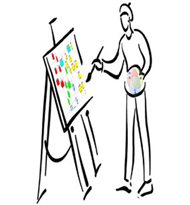 Would you build or purchase a house that does not have a Blueprint? It is not uncommon for enterprises to build or buy Software Applications without first having a discussion about the underlying information that the Software Applications are intended to address. As numerous Applications are introduced into an enterprise’s environment, there may be numerous dissimilar databases, multiple data models, or no data models at all.
Would you build or purchase a house that does not have a Blueprint? It is not uncommon for enterprises to build or buy Software Applications without first having a discussion about the underlying information that the Software Applications are intended to address. As numerous Applications are introduced into an enterprise’s environment, there may be numerous dissimilar databases, multiple data models, or no data models at all.
When individuals use these Software Applications, they perform the work within that specific Software Application’s ‘bubble’. This is how the ‘Silo-Effect’ takes shape in a given environment (select the ‘CBL Taxonomy’ item on the website Methodology page for an explanation of the ‘Silo-Effect’). Data Stewards and Data Architects can manage this process by establishing a Common Business Language Taxonomy (Figure 1) and a Decision Support Data Model (Figure 2) that reflects the language of the business across Organizational Units.
THE GITS METHODOLOGY EXPEDITES SOFTWARE IMPLEMENTATIONS & MITIGATES THE SILO-EFFECT
GITS can provide you with resources and training/training materials to show you the role of Data Governance, which includes conducting ‘Handshakes’ with the End Users to ascertain the needs of the business. We can train your Data Stewards on how to develop the Common Business Language Taxonomy Pallet that will be sustainable regardless of the Software Implementation. Once the Common Business Language is agreed upon, Data Governance can execute another ‘Handshake’ with with your differnt Software Applications, across geographical and organizational boundaries. This approach is more expeditious than the Business Requirements/Technical Specification narratives that are normally developed within the Software Development Life Cycle.